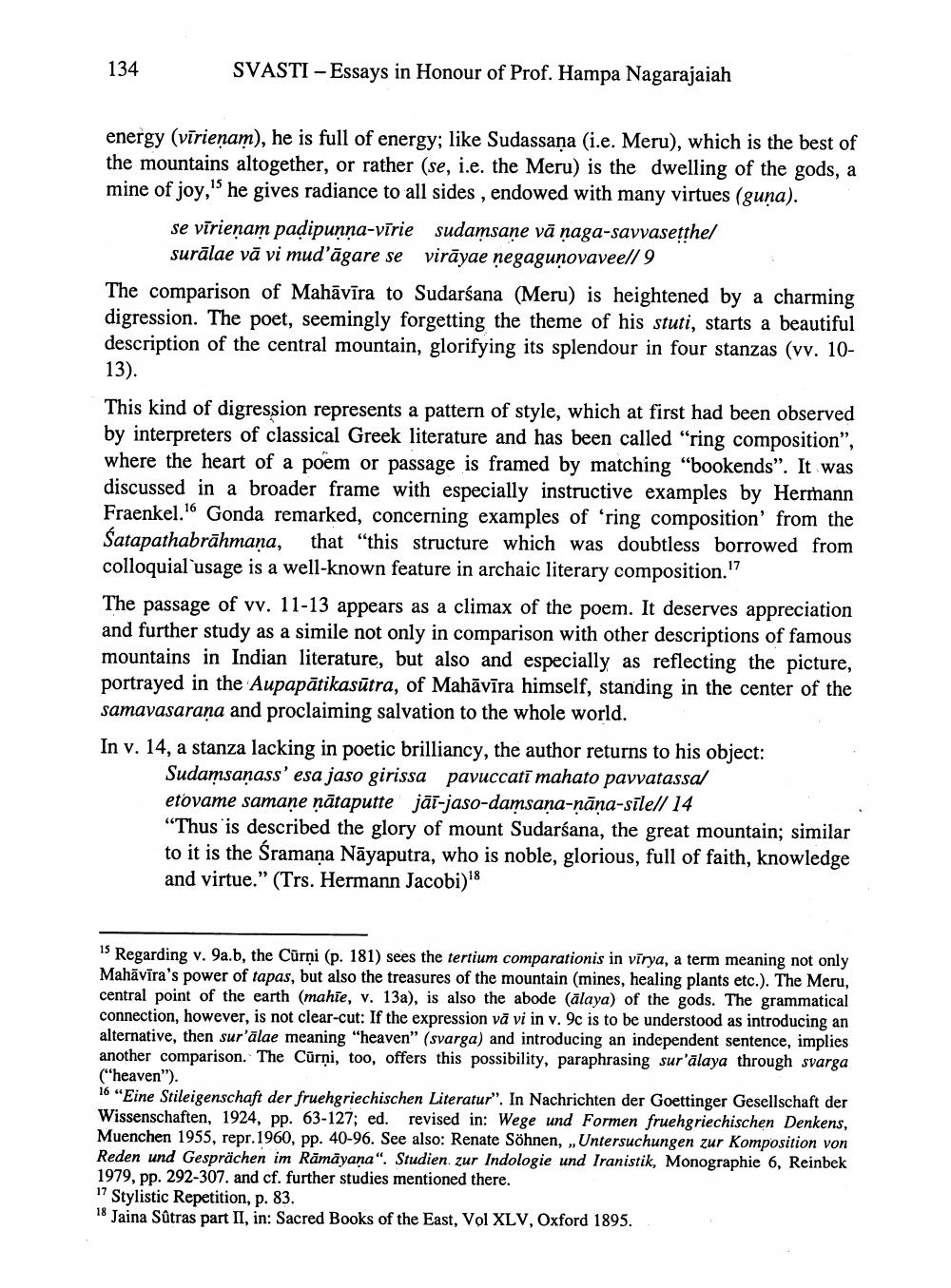________________
134
SVASTI – Essays in Honour of Prof. Hampa Nagarajaiah
energy (vīrienam), he is full of energy; like Sudassaņa (i.e. Meru), which is the best of the mountains altogether, or rather (se, i.e. the Meru) is the dwelling of the gods, a mine of joy,'' he gives radiance to all sides , endowed with many virtues (guna).
se vīrienam padipunna-vīrie sudamsane vā naga-savvasetthel
surālae vā vi mud'āgare se virāyae negaguņovaveell 9 The comparison of Mahāvīra to Sudarśana (Meru) is heightened by a charming digression. The poet, seemingly forgetting the theme of his stuti, starts a beautiful description of the central mountain, glorifying its splendour in four stanzas (vv. 10
13).
This kind of digression represents a pattern of style, which at first had been observed by interpreters of classical Greek literature and has been called "ring composition", where the heart of a poem or passage is framed by matching "bookends". It was discussed in a broader frame with especially instructive examples by Hermann Fraenkel. Gonda remarked, concerning examples of 'ring composition from the Satapathabrāhmana, that “this structure which was doubtless borrowed from colloquial usage is a well-known feature in archaic literary composition." The passage of vv. 11-13 appears as a climax of the poem. It deserves appreciation and further study as a simile not only in comparison with other descriptions of famous mountains in Indian literature, but also and especially as reflecting the picture, portrayed in the Aupapātikasūtra, of Mahāvīra himself, standing in the center of the samavasarana and proclaiming salvation to the whole world. In v. 14, a stanza lacking in poetic brilliancy, the author returns to his object:
Sudamsaņass' esa jaso girissa pavuccati mahato pavvatassa/ etovame samane ņātaputte jāi-jaso-damsana-nāna-sīlell 14 "Thus is described the glory of mount Sudarsana, the great mountain; similar to it is the Śramana Nāyaputra, who is noble, glorious, full of faith, knowledge and virtue." (Trs. Hermann Jacobi):
15 Regarding v. 9a.b, the Cūrņi (p. 181) sees the tertium comparationis in vīrya, a term meaning not only Mahāvīra's power of tapas, but also the treasures of the mountain (mines, healing plants etc.). The Meru, central point of the earth (mahie, v. 13a), is also the abode (ālaya) of the gods. The grammatical connection, however, is not clear-cut: If the expression vā vi in v. 9c is to be understood as introducing an alternative, then sur'ālae meaning "heaven" (svarga) and introducing an independent sentence, implies another comparison. The Cūrņi, too, offers this possibility, paraphrasing sur'ālaya through svarga ("heaven"). 16 "Eine Stileigenschaft der fruehgriechischen Literatur". In Nachrichten der Goettinger Gesellschaft der Wissenschaften, 1924, pp. 63-127; ed. revised in: Wege und Formen fruehgriechischen Denkens. Muenchen 1955, repr. 1960, pp. 40-96. See also: Renate Söhnen, Untersuchungen zur Komposition von Reden und Gesprächen im Rāmāyaṇa". Studien zur Indologie und Iranistik, Monographie 6, Reinbek 1979, pp. 292-307. and cf. further studies mentioned there. 17 Stylistic Repetition, p. 83. 18 Jaina Sûtras part II, in: Sacred Books of the East, Vol XLV, Oxford 1895.




